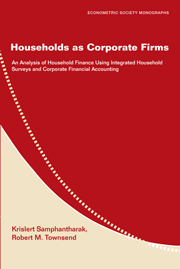 Households as Corporate Firms
Households as Corporate Firms Book contents
- Frontmatter
- Contents
- Preface
- PART I HOUSEHOLDS AS CORPORATE FIRMS
- PART II HOUSEHOLD FINANCIAL ACCOUNTING
- PART III HOUSEHOLD FINANCE
- 5 Financial Analysis
- 6 An Application: Liquidity Constraints, Kinship Networks, and the Financing of Household Investment
- 7 Discussion: Measurement and Modeling
- Appendix: Examples of Financial Statements
- References
- Index
- Titles in the series
6 - An Application: Liquidity Constraints, Kinship Networks, and the Financing of Household Investment
Published online by Cambridge University Press: 05 January 2013
- Frontmatter
- Contents
- Preface
- PART I HOUSEHOLDS AS CORPORATE FIRMS
- PART II HOUSEHOLD FINANCIAL ACCOUNTING
- PART III HOUSEHOLD FINANCE
- 5 Financial Analysis
- 6 An Application: Liquidity Constraints, Kinship Networks, and the Financing of Household Investment
- 7 Discussion: Measurement and Modeling
- Appendix: Examples of Financial Statements
- References
- Index
- Titles in the series
Summary
We showed in chapter 5 how to perform various simple financial analyses from the financial accounts constructed from a household survey. We did so by looking at two distinct households that we chose as our case studies. Although the case study approach gives us a lively story about the financial situations and behavior of these two households, it leaves us with a question whether the results from the case study households can be generalized to other households in the survey. This chapter takes an alternative approach and presents an application of household financial accounts to an analysis of the behavior of rural households from a larger set of the sampled households.
Specifically, we look at liquidity constraints and the financing of household investment in fixed assets. We find that rural households in our sample, especially the poor, seem to face liquidity constraints. These constraints are partially mitigated by kinship networks in the village. When we further analyze gift and borrowing transaction data, we find that the kinship effect for the poor households seems to be through both gifts and borrowings, while the effect for the rich households is more likely to be from gifts and not from borrowing. Using the accounting distinction between the use of a stock of cash and the cash flow, we find that rich households finance investment from previously accumulated cash, i.e. they use internally generated funds, symptomatic of constraints in a pecking order literature.
- Type
- Chapter
- Information
- Households as Corporate FirmsAn Analysis of Household Finance Using Integrated Household Surveys and Corporate Financial Accounting, pp. 117 - 150Publisher: Cambridge University PressPrint publication year: 2009


